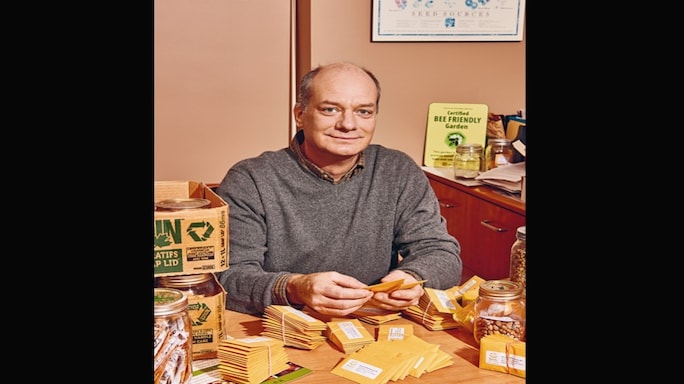Seed Savers
How amateur gardeners are protecting Canada’s botanical biodiversity
 The Canadian Seed Library’s Bob Wildfong. Photograph By Christie Vuong
The Canadian Seed Library’s Bob Wildfong. Photograph By Christie Vuong
A century ago, you needn’t travel far to find unique fruits or vegetables. Their names—be they Lakota squash or Aunt Astrida’s Latvian oxheart tomato—were a reflection of people and place. Today,because of the widespread adoption of industrial farming practices, about 90 per cent of North America’s fruit and vegetable varieties have become extinct. Worldwide, 75 per cent of crop diversity has been lost. With that does resilience against pests and future weather patterns, not to mention delicious flavours.
But a group of Canadians have taken crop diversity into their own gardening gloves.The rescue mission started in the early1980s with 100-some backyard gardeners scattered across British Columbia,Ontario and Quebec. Every year, they noticed more of their favourite plants disappearing from the seed catalogues. Big seed companies were buying up smaller ones, and as inventories were consolidated, beloved beans and broccolis vanished into obscurity. To keep their cherished varieties circulating, the gardeners decided to save and share their own seeds. Soon 1,000 of these guerrilla growers were mailing seeds across the country.In 1995, these gardeners formed Seeds of Diversity, a non-profit focussed on preserving Canada’s botanical heritage. A little over a decade later, the group launched the Canadian Seed Library to house each crop variety in circulation. “We designate buildings to be preserved. We designate landscapes to be preserved,” says Bob Wildfong, 54, the executive director of the organization for two decades. “We need to think of old varieties of plants as being in that same category.”
The Seed Library now stocks more than 2,900 seed varieties, stored in a closet at the nonprofit’s office in downtown Waterloo. A second backup library is stored in a walk-in freezer at an educational farm north of Guelph called Everdale, where Wildfong started a seed-growing programme in 2007.To keep the library well stocked, Seeds of Diversity also operates an adopt-a-seed programme; members pay between $50 and $250 (around 3,040 to `15,190)—the cost of full sponsorship—to induct a specific variety into the seed library for perpetuity.
Under the programme, volunteers sign up for spring growing, and tiny manila envelopes are mailed to each taker; the scarcest seeds are sent to the most experienced gardeners. At the end of the growing season, packages of fresh seeds are shipped back to Waterloo for drying, weighing and testing, before going into storage.
Wildfong’s current favourite seed is the purple striped pole bean, an old Mennonite variety from the Waterloo area. He says the humble bean signifies something he’s found most beautiful about seed saving: the personal connections between people and families.“I’m growing this Mennonite bean, and it’s not from my family,” Wildfong says.
“But now it’s part of my life, and I would like someone else to adopt it so it becomes part of their life, too.”
Laurie Graham, 46, and her mother, Wilda Bostwick, 76, might do just that. They’ve already sponsored the Croatian blue pole bean, plus the year-round lettuce, the Slocan pea, and the white Sokol bread seed poppy. Graham, who lives in Toronto, started seed-sponsoring in 2012 as a gift to Bostwick, who grew up on a family farm and now lives in Vancouver. Graham first chose a sugar snap pea, like the ones her mom used to grow when Graham was a child. When the next holiday rolled around, Bostwick reciprocated, and a new tradition was forged.
Graham says it’s meaningful to do her part in helping bring seeds back from the brink. “People work together to get seeds into a more viable state,” she says. “It’s a partnership."






